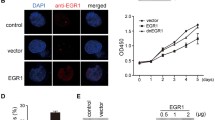Abstract
Transcription Elongation Factor A-like 7 (TCEAL7) was first reported as a candidate tumor suppressor gene because of its inactivation in ovarian cancer as a result of promoter methylation. Down-regulation of the TCEAL7 gene expression was also associated with other cancers such as endometrial, breast, brain, prostate, gastric cancers, glioblastoma and linked to tumor phenotypes and clinical outcomes. However, there is no report in the literature investigating the role of TCEAL7 in non-small cell lung cancer. Cyclin D1 is an important molecule in the transition from G1 to S phase of the cell cycle, and is frequently deregulated in cancers. Cylin D1 (CCND1) gene is amplified or overexpressed in a variety of tumors. In our previous study we reported that CCND1 over-expression was not associated with amplification in non-small cell lung cancer. Recently, it has been reported that TCEAL7 regulates CCND1 expression through myc-binding E-box sequences. The aim of this study was to investigate the expression of TCEAL7 gene in non-small cell lung cancer and to determine its effect on the CCND1 expression level. For this purpose, expression levels of TCEAL7 and CCND1 genes were investigated in 50 patients with non-small cell lung cancer by quantitative real time polymerase chain reaction (qRT-PCR). TCEAL7 was under-expressed (68%) in non-small cell lung cancer tumor tissues while CCND1 was over-expressed (42%). The TCEAL7 levels negatively correlated with increased CCND1 expression (p = 0.002).


Similar content being viewed by others
References
Stacey DW (2003) Cyclin D1 serves as a cell cycle regulatory switch in actively proliferating cells. Curr Opin Cell Biol 15:158–163
Muller H, Lukas J, Schneider A, Warthoe P, Bartek J, Eilers M, Strauss M (1994) Cyclin D1 expression is regulated by the retinoblastoma protein. Proc Natl Acad Sci USA 91:2945–2949
Olashaw N, Pledger WJ (2002) Paradigms of growth control: relation to Cdk activation. Sci STKE 2002:re7. https://doi.org/10.1126/stke.2002.134.re7
Sherr CJ, Roberts JM (1999) CDK inhibitors: positive and negative regulators of G1-phase progression. Genes Dev 13:1501–1512
Lammie GA, Peters G (1991) Chromosome 11q13 abnormalities in human cancer. Cancer Cells 3:413–420
Baykara O, Dalay N, Bakir B, Bulut P, Kaynak K, Buyru N (2017) The EMSY gene collaborates with CCND1 in non-small cell lung carcinogenesis. Int J Med Sci 14:675–679. https://doi.org/10.7150/ijms.19355
Betticher DC, Heighway J, Hasleton PS, Altermatt HJ, Ryder WD, Cerny T, Thatcher N (1996) Prognostic significance of CCND1 (cyclin D1) overexpression in primary resected non-small-cell lung cancer. Br J Cancer 73:294–300
Baltaci E, Karaman E, Dalay N, Buyru N (2016) Analysis of gene copy number changes in head and neck cancer. Clin Otolaryngol. https://doi.org/10.1111/coa.12686
Callender T, el-Naggar AK, Lee MS, Frankenthaler R, Luna MA, Batsakis JG (1994) PRAD-1 (CCND1)/cyclin D1 oncogene amplification in primary head and neck squamous cell carcinoma. Cancer 74:152–158
Veltman JA et al (2003) Array-based comparative genomic hybridization for genome-wide screening of DNA copy number in bladder tumors. Cancer Res 63:2872–2880
Bartkova J, Lukas J, Muller H, Lutzhoft D, Strauss M, Bartek J (1994) Cyclin D1 protein expression and function in human breast cancer. Int J Cancer 57:353–361
Baykara O, Bakir B, Buyru N, Kaynak K, Dalay N (2015) Amplification of chromosome 8 genes in lung cancer. J Cancer 6:270–275. https://doi.org/10.7150/jca.10638
Chien J et al (2005) Epigenetic silencing of TCEAL7 (Bex4) in ovarian cancer. Oncogene 24:5089–5100. https://doi.org/10.1038/sj.onc.1208700
Brown AL, Kay GF (1999) Bex1, a gene with increased expression in parthenogenetic embryos, is a member of a novel gene family on the mouse X chromosome. Hum Mol Genet 8:611–619
Strausberg RL et al (2002) Generation and initial analysis of more than 15,000 full-length human and mouse cDNA sequences. Proc Natl Acad Sci USA 99:16899–16903. https://doi.org/10.1073/pnas.242603899
Chien J et al (2008) A role for candidate tumor-suppressor gene TCEAL7 in the regulation of c-Myc activity, cyclin D1 levels and cellular transformation. Oncogene 27:7223–7234. https://doi.org/10.1038/onc.2008.360
Rattan R, Narita K, Chien J, Maguire JL, Shridhar R, Giri S, Shridhar V (2010) TCEAL7, a putative tumor suppressor gene, negatively regulates NF-kappaB pathway. Oncogene 29:1362–1373. https://doi.org/10.1038/onc.2009.431
Peedicayil A et al (2009) Polymorphisms in TCEAL7 and risk of epithelial ovarian cancer. Gynecol Oncol 114:260–264. https://doi.org/10.1016/j.ygyno.2009.03.038
Guo Y, Liao Y, Jia C, Ren J, Wang J, Li T (2013) MicroRNA-182 promotes tumor cell growth by targeting transcription elongation factor A-like 7 in endometrial carcinoma. Cell Physiol Biochem 32:581–590. https://doi.org/10.1159/000354462
Huang CY et al (2013) Decreased expression of transcription elongation factor A-like 7 is associated with gastric adenocarcinoma prognosis. PLoS ONE 8:e54671. https://doi.org/10.1371/journal.pone.0054671
Schmittgen TD, Livak KJ (2008) Analyzing real-time PCR data by the comparative C(T) method. Nat Protoc 3:1101–1108
Knudsen KE, Diehl JA, Haiman CA, Knudsen ES (2006) Cyclin D1: polymorphism, aberrant splicing and cancer risk. Oncogene 25:1620–1628. https://doi.org/10.1038/sj.onc.1209371
Funding
This study was funded by Istanbul University with the Grant Number 21387.
Author information
Authors and Affiliations
Corresponding author
Ethics declarations
Conflict of interest
The authors declare that they have no conflict of interests.
Ethical approval
The Ethics Committee of Istanbul University, Cerrahpasa Medical Faculty, approved the study (No: 84996).
Additional information
Publisher's Note
Springer Nature remains neutral with regard to jurisdictional claims in published maps and institutional affiliations.
Electronic supplementary material
Below is the link to the electronic supplementary material.
Rights and permissions
About this article
Cite this article
Orhan, C., Bulut, P., Dalay, N. et al. Downregulation of TCEAL7 expression induces CCND1 expression in non-small cell lung cancer. Mol Biol Rep 46, 5251–5256 (2019). https://doi.org/10.1007/s11033-019-04982-6
Received:
Accepted:
Published:
Issue Date:
DOI: https://doi.org/10.1007/s11033-019-04982-6




